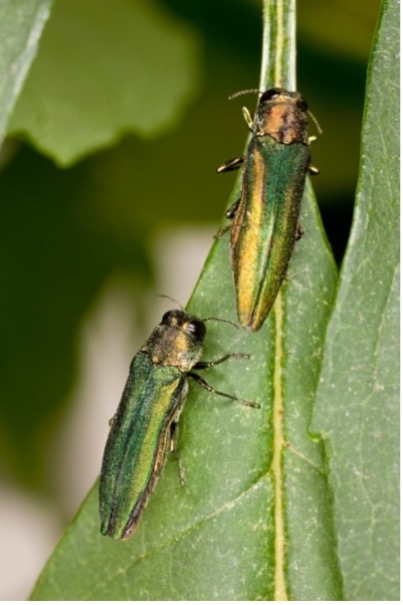The invasive pest spotlight focuses on emerging or potential invasive pests in California. In this issue we are covering the emerald ash borer.

Emerald Ash Borer Facts
The emerald ash borer is a small (roughly 3/8 to 5/8 inches long) beetle with metallic green wing covers and a coppery red or purple abdomen. While there are other metallic wood-boring beetles, the emerald ash borer's body is longer and more cylindrical than others. Adults feed on the edges of leaves and lay eggs under tree bark flaps and in bark crevices. Once the eggs hatch, the larvae burrow into the tree to feed, creating S-shaped galleries in the wood. This disrupts the flow of nutrients through the tree and causes branch dieback and death of the infested tree in as little as two years. After pupating within the tree, they emerge as adult beetles, leaving behind D-shaped exit holes in the bark.
The emerald ash borer has killed over 40 million healthy ash trees in the United States since it was discovered in Michigan in 2002. As of 2018, this pest has spread to over 35 states and 5 Canadian provinces. Ash trees, olive trees, and other woody trees in the olive family are all susceptible to attack. In California, the native Oregon ash is highly susceptible to emerald ash borer attack. This pest is not currently established in California, but its introduction here could devastate our forests.
What can you do?
The beetle doesn't fly far, and most long-distance movement of emerald ash borer has been directly traced to ash firewood or ash nursery stock. California currently has a regulation restricting the importation of ash firewood and other potentially infested material to protect our environment from this pest. You can help prevent the emerald ash borer from moving into California. Buy or gather firewood near where you'll burn it and don't bring home any leftover wood. Certified heat-treated firewood is safe to move long distances. Look for a state or federal stamp or seal on the package.
For more information, see the California Department of Food and Agriculture's Pest Profile at https://www.cdfa.ca.gov/plant/PDEP/target_pest_disease_profiles/eab_profile.html
[Originally featured in the Spring 2023 issue of UC IPM's Home & Garden Pest Newsletter]